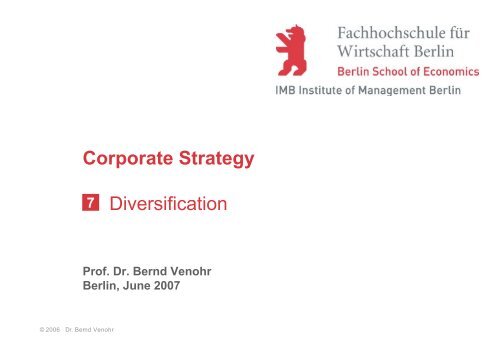Corporate Strategy Diversification - Prof. Dr. Bernd Venohr
Corporate Strategy Diversification - Prof. Dr. Bernd Venohr
Corporate Strategy Diversification - Prof. Dr. Bernd Venohr
You also want an ePaper? Increase the reach of your titles
YUMPU automatically turns print PDFs into web optimized ePapers that Google loves.
© 2006 <strong>Dr</strong>. <strong>Bernd</strong> <strong>Venohr</strong><br />
<strong>Corporate</strong> <strong>Strategy</strong><br />
7<br />
<strong>Diversification</strong><br />
<strong>Prof</strong>. <strong>Dr</strong>. <strong>Bernd</strong> <strong>Venohr</strong><br />
Berlin, June 2007
Agenda (NEU)<br />
Introduction to <strong>Strategy</strong><br />
1<br />
2<br />
3<br />
4<br />
Business <strong>Strategy</strong><br />
5<br />
6<br />
7<br />
© 2006 <strong>Dr</strong>. <strong>Bernd</strong> <strong>Venohr</strong><br />
Course Overview and <strong>Strategy</strong> Concept<br />
Communication and Problem Solving<br />
Economics of <strong>Strategy</strong><br />
Shareholder Value<br />
External Environment<br />
Internal Environment<br />
Competitive Positioning<br />
<strong>Corporate</strong> <strong>Strategy</strong><br />
8<br />
9<br />
10<br />
<strong>Strategy</strong> Process<br />
11<br />
12<br />
<strong>Diversification</strong><br />
Mergers & Acquisitions<br />
Global <strong>Strategy</strong><br />
Organizational Structure and Control<br />
Strategic Leadership<br />
2
Where are we today?<br />
External<br />
Environment<br />
© 2006 <strong>Dr</strong>. <strong>Bernd</strong> <strong>Venohr</strong><br />
Introduction to <strong>Strategy</strong><br />
Business <strong>Strategy</strong> <strong>Corporate</strong> <strong>Strategy</strong><br />
5 6<br />
7<br />
Competitive<br />
Positioning<br />
1 <strong>Strategy</strong> Concept 2<br />
Economics of<br />
<strong>Strategy</strong><br />
3 3 4<br />
Internal<br />
Environment<br />
<strong>Strategy</strong> Process<br />
11<br />
12<br />
Organizational<br />
Structure and<br />
Control<br />
Strategic<br />
Leadership<br />
Communication and<br />
Problem Solving<br />
Shareholder Value<br />
8<br />
Mergers &<br />
Acquisitions<br />
<strong>Diversification</strong><br />
9 10<br />
Global<br />
<strong>Strategy</strong><br />
3
<strong>Corporate</strong> vs. business level strategy: a diversified company,<br />
which is active in more than one business, has two levels of<br />
strategy (BITTE LOGOS DP HINEINKOPIEREN(<br />
Example: Deutsche Post World Net<br />
CORPORATE<br />
LEVEL<br />
BUSINESS<br />
LEVEL<br />
Mail<br />
Source: Corey Phelps; Mgmt 430<br />
© 2006 <strong>Dr</strong>. <strong>Bernd</strong> <strong>Venohr</strong><br />
Express<br />
Example: Deutsche Post World Net<br />
DPWN<br />
Logistics<br />
Financial<br />
Services<br />
4
Key issues corporate versus business strategy<br />
CORPORATE STRATEGY: How to create a competitive advantage<br />
for the whole company<br />
� What businesses should we be in?<br />
� How should these be managed?<br />
� How to create value for the corporation as a whole?<br />
BUSINESS STRATEGY: How to create a competitive advantage in<br />
specific, individual product markets<br />
� Which customers to serve (who?) – segmentation<br />
� Which customers needs to satisfy (what?) – differentiation<br />
� Resources and value chain activities necessary to satisfying customer<br />
needs (how?) – “core competencies”<br />
© 2006 <strong>Dr</strong>. <strong>Bernd</strong> <strong>Venohr</strong><br />
5
Key Challenges for a value-creating corporate strategy<br />
� Direct competition occurs at the business unit level<br />
� <strong>Corporate</strong> <strong>Strategy</strong> adds costs and constraints to business<br />
units<br />
� Shareholders can easily diversify themselves<br />
Source: Porter, From competitive advantage to corporate strategy<br />
© 2006 <strong>Dr</strong>. <strong>Bernd</strong> <strong>Venohr</strong><br />
6
Goal of <strong>Corporate</strong> <strong>Strategy</strong>: create corporate advantage<br />
� Goal of corporate strategy<br />
- to build corporate advantage<br />
- earn above normal returns<br />
� Three tests on the existence of corporate advantage<br />
- Does ownership of the business create benefit<br />
somewhere in the corporation? (Does parentage matter?)<br />
- Are those benefits greater than the cost of corporate<br />
overhead?<br />
- Does the corporation create more value with the business<br />
than any other possible corporate parent or alternative<br />
governance structure?<br />
Source: Collis and Montgomery, 1998<br />
© 2006 <strong>Dr</strong>. <strong>Bernd</strong> <strong>Venohr</strong><br />
7
Focus of corporate strategy: where a firm competes,<br />
i.e. the scope of its activities<br />
[A] Single<br />
Integrated<br />
Firm<br />
[B] Several<br />
Specialized<br />
Firms linked<br />
by Markets<br />
© 2006 <strong>Dr</strong>. <strong>Bernd</strong> <strong>Venohr</strong><br />
Vertical Market - Geographical<br />
Scope Scope Scope<br />
V 1<br />
V 2<br />
V 3<br />
V 1<br />
V 2<br />
V 3<br />
P 1<br />
P 2<br />
P 3<br />
C 1<br />
C 2<br />
C 3<br />
P 1 P 2 P 3 C 1 C 2 C 3<br />
In situation [A] the business units are integrated within a single firm.<br />
In situation [B] the business units are independent firms linked by markets.<br />
Are the administrative costs of the integrated firm less than the transaction<br />
costs of markets?<br />
Source: Robert M. Grant, Contemporary <strong>Strategy</strong> Analysis: Concepts, Techniques, Applications (5th edition, Blackwell, 2004)
<strong>Corporate</strong> strategy: diversification into new areas by<br />
employing one of the three levers<br />
1<br />
2<br />
3<br />
Markets: Products and Services and Customer segments<br />
Vertical: Value Chain<br />
Geography<br />
© 2006 <strong>Dr</strong>. <strong>Bernd</strong> <strong>Venohr</strong><br />
9
Levels and types of diversification: the“related ratio”<br />
Low Levels of <strong>Diversification</strong><br />
Single business<br />
Moderate to High Levels of <strong>Diversification</strong><br />
Related linked (mixed) < 70% of revenues from dominant<br />
business, only limited links exist<br />
Very High Levels of <strong>Diversification</strong><br />
> 95% of revenues from single<br />
business unit<br />
Dominant business Between 70% and 95% of<br />
revenues from single business unit<br />
Related constrained<br />
Unrelated-<br />
< 70% of revenues from dominant<br />
business; all businesses share<br />
activities in value chain<br />
Business units not closely related<br />
Source: Robert M. Grant, Contemporary <strong>Strategy</strong> Analysis: Concepts, Techniques, Applications (5th edition, Blackwell,<br />
2004)<br />
Diversified<br />
© 2006 <strong>Dr</strong>. <strong>Bernd</strong> <strong>Venohr</strong><br />
A<br />
B<br />
A<br />
A<br />
B C<br />
A<br />
B C<br />
A<br />
B C<br />
10
Two alternative diversification strategies:<br />
related versus unrelated<br />
� Related diversification strategies: firm moves from a core of activities<br />
in a specific product market to other related activities and markets<br />
– Demand and/or cost linkages between lines of business<br />
– Sharing value chain activities and transferring core competencies<br />
� Unrelated diversification strategies<br />
– Replace external capital market with internal capital market allocation<br />
– No linkages between businesses<br />
Source: Corey Phelps; Mgmt 430<br />
© 2006 <strong>Dr</strong>. <strong>Bernd</strong> <strong>Venohr</strong><br />
11
Two directions of related diversification:<br />
vertical and horizontal<br />
� Horizontal diversification (HD) : different businesses in similar stage of<br />
value chain<br />
– concentric diversification: businesses are highly related<br />
– conglomerate: businesses are unrelated<br />
� Vertical diversification (VD) : Number of stages a firm engages in the<br />
value chain<br />
– Forward (into distribution channels) vs. backward integration (sources of<br />
supply)<br />
– Make vs. buy<br />
Source: Corey Phelps; Mgmt 430<br />
© 2006 <strong>Dr</strong>. <strong>Bernd</strong> <strong>Venohr</strong><br />
12
Vertical <strong>Diversification</strong>:<br />
Number of stages a firm engages in the value chain<br />
Source: Corey Phelps; Mgmt 430<br />
© 2006 <strong>Dr</strong>. <strong>Bernd</strong> <strong>Venohr</strong><br />
Vertical Dimension<br />
IT Hardware<br />
Software<br />
IT Consulting and<br />
Outsourcing<br />
13
Horizontal <strong>Diversification</strong>: number of different product<br />
markets a company is active in<br />
Source: Corey Phelps; Mgmt 430<br />
© 2006 <strong>Dr</strong>. <strong>Bernd</strong> <strong>Venohr</strong><br />
Power<br />
Generation<br />
Horizontal <strong>Diversification</strong><br />
I&C<br />
Net-works<br />
Medical<br />
Solutions<br />
14
Degree of vertical diversification (integration)<br />
explained by transaction cost theory<br />
� Developed by Ronald Coase ( Nobel Memorial Prize in<br />
Economics in 1991 ; The Nature of the Firm)<br />
� Why economy is populated by a number of business firms,<br />
instead of consisting exclusively of a many independent, selfemployed<br />
people who contract with one another ?<br />
� Key driver: transaction costs of the market (= cost of<br />
locating, negotiating, and enforcing a contract) . Firms will arise<br />
when they can arrange to produce what they need internally<br />
and avoid these costs.<br />
� There is a natural limit to what can be produced internally :<br />
"decreasing returns to the entrepreneurial function“ ( overhead<br />
costs and mistakes in resource allocation)<br />
Source: Coase, Ronald. "The Nature of the Firm".; Wikepedia<br />
© 2006 <strong>Dr</strong>. <strong>Bernd</strong> <strong>Venohr</strong><br />
15
Vertical diversification: Owning and directing additional<br />
activities makes sense if external markets don‘t function well<br />
� Activity is more efficient within the firm (cost / benefit)<br />
– Lower transaction costs and improved coordination vs.<br />
– Sacrifice scale/scope economies<br />
� Protect leakage of technology<br />
� Create market power via creation of entry barriers<br />
– Integrate backwards: buy up key supplier<br />
– Integrate forward: lock up distribution<br />
� Undo effects of market power: eliminate market power of supplier or buyer<br />
� Acquire information about value chain steps<br />
Source: Robert M. Grant, Contemporary <strong>Strategy</strong> Analysis: Concepts, Techniques, Applications (5th edition, Blackwell, 2004)<br />
© 2006 <strong>Dr</strong>. <strong>Bernd</strong> <strong>Venohr</strong><br />
16
Vertical diversification: Some Vertical Integration Fallacies<br />
� Firms should make (integrate) to keep for themselves profits earned<br />
by market firms: profits represent returns necessary to attract investment<br />
and would be required of any firm<br />
� Vertically integrated firms can produce an input at cost and will have<br />
cost advantage over nonintegrated firms who have to buy inputs at<br />
market prices<br />
– hidden opportunity costs for vertically integrated firm: no sales in open<br />
market (less scale economies); less competitive pressures<br />
– increasing cost of coordinating vertical activities<br />
Source: Robert M. Grant, Contemporary <strong>Strategy</strong> Analysis: Concepts, Techniques, Applications (5th edition, Blackwell, 2004)<br />
© 2006 <strong>Dr</strong>. <strong>Bernd</strong> <strong>Venohr</strong><br />
17
Vertical diversification:<br />
recent trends in vertical relationships<br />
� From competitive contracting to supplier partnerships, e.g. in autos<br />
� From vertical integration to outsourcing (not just components, also IT,<br />
distribution, and administrative services)<br />
� Diffusion of franchising<br />
� Technology partnerships (e.g. IBM-Apple; Canon-HP)<br />
� Inter-firm networks<br />
General conclusion:<br />
Boundaries between firms and markets becoming increasingly blurred.<br />
Source: Robert M. Grant, Contemporary <strong>Strategy</strong> Analysis: Concepts, Techniques, Applications (5th edition, Blackwell, 2004)<br />
© 2006 <strong>Dr</strong>. <strong>Bernd</strong> <strong>Venohr</strong><br />
18
Vertical diversification: Different Types of Vertical Relationships<br />
Low Formalization High<br />
Spot sales/<br />
purchases<br />
© 2006 <strong>Dr</strong>. <strong>Bernd</strong> <strong>Venohr</strong><br />
Long-term<br />
contracts<br />
Agency<br />
agreements<br />
Informal<br />
supplier/<br />
customer<br />
relationships<br />
Franchises<br />
Supplier/<br />
customer<br />
partnerships<br />
Joint<br />
ventures<br />
Vertical<br />
integration<br />
Low Degree of Commitment High<br />
Source: Robert M. Grant, Contemporary <strong>Strategy</strong> Analysis: Concepts, Techniques, Applications (5th edition, Blackwell, 2004)
Horizontal diversification benefits (synergies) arise<br />
because of shared resources that exist across product<br />
market boundaries<br />
� Cost-driven synergies: Sharing of activities lowers costs<br />
– Supply-based joint resources (Economies of scope): if a firm produces two<br />
related products, the total costs of producing them jointly is lower than the sum of<br />
the cost of producing them separately (share fixed costs between different<br />
products) due to resource sharing.<br />
– Examples : common distribution facilities, brands, joint R&D<br />
� Demand-based synergies: raise differentiation<br />
– customers perceive linkages in products<br />
– risky, since quite often based on customers cognitive links betweeen products<br />
(„perceptions“) which can change quickly<br />
Source: Corey Phelps; Mgmt 430<br />
© 2006 <strong>Dr</strong>. <strong>Bernd</strong> <strong>Venohr</strong><br />
20
Horizontal diversification: Identify cross-business shared<br />
resources by comparing value chains across businesses<br />
Business A<br />
Business B<br />
Business C<br />
Business D<br />
Business E<br />
© 2006 <strong>Dr</strong>. <strong>Bernd</strong> <strong>Venohr</strong><br />
Inbound<br />
Logistics<br />
Technology Operations<br />
Value Chain Activities<br />
Sales and<br />
Marketing<br />
Distribution Service<br />
Opportunity to combine purchasing activities (gain more leverage with suppliers)<br />
Opportunity to share technology, transfer technical skills, combine R&D<br />
Opportunity to combine sales & marketing activities, use common distribution channels,<br />
leverage use of a common brand name, and/or combine after-sale service<br />
No sharing<br />
Source: Robert M. Grant, Contemporary <strong>Strategy</strong> Analysis: Concepts, Techniques, Applications (5th edition, Blackwell, 2004)<br />
21
Example horizontal diversification: Procter & Gamble<br />
using a common physical distribution system and<br />
sales force<br />
Procter & Gamble Strategic Field<br />
Source: Walker W. Lewis, „The CEO and <strong>Corporate</strong> <strong>Strategy</strong> in the 80‘s: Back to Basics“, 1984<br />
Reprinted by permission of The institute of Management Sciences, Providence, RI<br />
© 2006 <strong>Dr</strong>. <strong>Bernd</strong> <strong>Venohr</strong><br />
22
Horizontal diversification:<br />
Transferring Core Competencies<br />
� Exploit intangible interrelationships among divisions<br />
� Identify ability to transfer skills and expertise among similar value chains<br />
(across divisions)<br />
– Activities must be sufficiently similar that sharing is possible<br />
– Transfer of skills involve activities which are important to competitive advantage<br />
– The skills transferred represent significant sources of advantage for the receiving<br />
business unit<br />
� Examples:<br />
– Deutsche Post logistics expertise<br />
– Toyota’s core competence in engines<br />
– Apple`s core competence in design<br />
Source: Corey Phelps; Mgmt 430<br />
© 2006 <strong>Dr</strong>. <strong>Bernd</strong> <strong>Venohr</strong><br />
23
Horizontal diversification: Significant management<br />
challenges in actually achieving the potential benefits<br />
� <strong>Diversification</strong> alone will not produce superior performance: “benefits<br />
don’t just happen”<br />
� Management skills in capturing potential benefits of interrelationships<br />
are a key success factor<br />
� Key levers are:<br />
– strong sense of corporate identity and mission that emphasizes the<br />
importance of integrating business units<br />
– allocation of management attention<br />
– allocation of capital and shared resources to different business units<br />
– management hiring/training<br />
– incentive systems that reward more than just business unit performance<br />
© 2006 <strong>Dr</strong>. <strong>Bernd</strong> <strong>Venohr</strong><br />
24
Unrelated <strong>Diversification</strong>: diversifying into businesses<br />
with no meaningful value chain relationships or demand<br />
side synergies<br />
� Conglomerates/Holding Companies: to venture into “any business in which we think we<br />
can make a profit”<br />
� Assumptions<br />
– Managers have superior information vs. outside investors<br />
– Top management can more precisely allocate resources to businesses than external<br />
market<br />
� Key characteristics of unrelated diversification<br />
– Often pursued through acquisitions: sound companies in attractive markets<br />
– Acquired businesses will stay autonomous<br />
– <strong>Corporate</strong> headquarter acts as portfolio manager<br />
© 2006 <strong>Dr</strong>. <strong>Bernd</strong> <strong>Venohr</strong><br />
• Supplies needed capital to each business<br />
• Transfers resources from “cash cows” to businesses with high growth potential<br />
– Add professional management and strict financial controls<br />
– Unit managers compensated on unit results<br />
Source: Corey Phelps; Mgmt 430<br />
25
Example of unrelated diversification: Virgin Group<br />
*Source: virgin.com Homepage<br />
© 2006 <strong>Dr</strong>. <strong>Bernd</strong> <strong>Venohr</strong><br />
26
Example of unrelated diversification: Virgin Group -<br />
Richard Branson as founder and CEO<br />
© 2006 <strong>Dr</strong>. <strong>Bernd</strong> <strong>Venohr</strong><br />
27
Unrelated diversification: benefits and risks<br />
� Potential benefits<br />
– Business risk scattered over different industries<br />
– Financial resources directed to those industries offering best profit<br />
prospects<br />
– Stability of profits : Hard times in one industry may be offset by good<br />
times in another industry<br />
– If bargain-priced firms with big profit potential are bought, shareholder<br />
wealth can be enhanced<br />
� Potential risks<br />
– Difficulties of competently managing many diverse businesses<br />
– Lack of strategic fit which can be leveraged into competitive advantage<br />
– Consolidated performance of unrelated businesses tends to be no better<br />
than sum of individual businesses on their own (and it may be worse). “1<br />
+ 1 = 2”, rather than “1 + 1 =3”<br />
– Promise of greater sales-profit stability over business cycles seldom<br />
realized<br />
© 2006 <strong>Dr</strong>. <strong>Bernd</strong> <strong>Venohr</strong><br />
28
Theory of unrelated diversification:<br />
Why an internal capital market can be more efficient<br />
than the external capital market?<br />
� Create value by exploiting financial economies: large organizations<br />
can fund projects more quickly and economically than external market<br />
– small projects are bundled<br />
– large projects can be taken on<br />
– key challenge :find products and markets that provide negatively<br />
correlated cash flows<br />
� Reduce funding costs through superior financial resource allocation:<br />
internal capital market is like a debt market with all the benefits of<br />
equity ownership<br />
– resolve borrower-lender problem (“moral hazard”):<br />
– internal funding allows for information sharing and better control over the<br />
use of funds by the “lender”<br />
– less likely that borrower and lender expropriate each other<br />
Source: Corey Phelps; Mgmt 430<br />
© 2006 <strong>Dr</strong>. <strong>Bernd</strong> <strong>Venohr</strong><br />
29
Theory of unrelated diversification:<br />
common diversification problems<br />
� Internal capital markets are less efficient than external ones<br />
– Higher quality information not guaranteed<br />
– Individual investors can generally diversify more effectively<br />
– Capital allocation can quickly stretch abilities of top managers<br />
� Managers’ personal interests drive diversification decision<br />
– Top executives’ compensation often based on “peer companies”<br />
(diversify to increase compensation) : empire building<br />
– When diversification buffers performance it’s harder for top execs to get<br />
fired (Reduce employment risk)<br />
– Poor performance may lead firms to diversify to achieve better returns<br />
(“the grass is always greener…)<br />
Source: Corey Phelps; Mgmt 430<br />
© 2006 <strong>Dr</strong>. <strong>Bernd</strong> <strong>Venohr</strong><br />
30
Underrated „good reason“ for unrelated diversification:<br />
business life cycles<br />
� All business go through life cycles no matter how good a business is today<br />
, it will eventually mature and decline<br />
� Companies in growth industries should devote the majority of their<br />
management time and attention to exploit the potential<br />
� Corporations in maturing industries with little diversification and low<br />
expected long-term growth should introduce growth businesses into their<br />
portfolio: here most of the benefits of moderate diversification can be<br />
achieved.<br />
� Anecdotal evidence: the experience of very old and still very successful<br />
companies like Haniel or Siemens (all active in several businesses; in most<br />
cases original business has been shed)<br />
© 2006 <strong>Dr</strong>. <strong>Bernd</strong> <strong>Venohr</strong><br />
31
Moderate levels of diversification yield higher levels<br />
of performance than either limited or extensive<br />
diversification (1)*<br />
Performance<br />
*Source: Palich/ Cardinal/ Chet Miller, 2000<br />
© 2006 <strong>Dr</strong>. <strong>Bernd</strong> <strong>Venohr</strong><br />
Single/<br />
Dominant<br />
Business<br />
Level of <strong>Diversification</strong><br />
Related Unrelated<br />
32
New Assignment and Outlook next Session<br />
� Read slides on session 7 on ILIAS<br />
� Visit company web pages and prepare as team a brief description<br />
of your companies corporate strategy (degree of relatedness; potential linkages<br />
among businesses)<br />
� Topics of next session:<br />
– Brief page presentation on each company; send in advance per e-mail or bring<br />
presentation on usb stick<br />
– Lecture: <strong>Corporate</strong> <strong>Strategy</strong>: M&A<br />
© 2006 <strong>Dr</strong>. <strong>Bernd</strong> <strong>Venohr</strong><br />
33
Appendix<br />
© 2006 <strong>Dr</strong>. <strong>Bernd</strong> <strong>Venohr</strong><br />
34
Remarks-Premises of <strong>Corporate</strong> <strong>Strategy</strong><br />
� Direct competition occurs at the business unit level<br />
- Corporations don’t compete; only their business units do<br />
- Value created at the business unit level, only added at the corporate level<br />
- Successful corporate strategy must grow out of and reinforce business strategy<br />
� <strong>Corporate</strong> <strong>Strategy</strong> inevitably adds costs and constraints to business units<br />
- <strong>Corporate</strong> overhead<br />
- Costs of coordination and monitoring: communication between headquarter and<br />
business units<br />
� Shareholders can easily diversify themselves<br />
- Shareholders can diversify their own portfolios of stocks, and they can often do it<br />
more cheaply with less risk than corporations<br />
- Shareholders can buy shares at market prices and avoid paying large acquisition<br />
premiums<br />
Source: Porter, From competitive advantage to corporate strategy<br />
© 2006 <strong>Dr</strong>. <strong>Bernd</strong> <strong>Venohr</strong><br />
35
Vertical diversification: Transactions cost exist,<br />
when there is market failure (market transactions<br />
inappropriate or too costly), which in turn lead to firms<br />
vertically integrating<br />
� A vertical market "fails" when transactions within it are too risky and the contracts designed to<br />
overcome these risks are too costly (or impossible) to write and administer. Where transaction costs<br />
are high , the firm is a more efficient means of organization<br />
� Examples (causes) of“market failures”:<br />
– One Seller, One Buyer<br />
– Difficulty in Writing Contracts: Bounded Rationality; Opportunism; Pre – Adverse Selection; Post - --<br />
Moral Hazard<br />
– Asset Specificity<br />
– Frequency of Transaction: The more frequent a transaction, all else equal, the more likely integration will<br />
occur<br />
� By vertically integrating a firm makes its resource decisions internally, using management<br />
mechanisms, as opposed to using the market . The objective is to adopt the organizational mode that<br />
best economizes on transaction costs, minimizes the risk of market failure, while taking into account the<br />
expense of governance costs. Firms must balance transaction costs with the cost of governance.<br />
� Rapid decline of vertical integration in the last few years: rise of outsourcing<br />
– advances of computer technology allow for easy cooperation between companies (lowering transaction<br />
costs and incentive and coordination poblems)<br />
– increased ability to write more complete and enforceable contracts<br />
Source: Coase, Ronald. "The Nature of the Firm".; Wikepedia<br />
© 2006 <strong>Dr</strong>. <strong>Bernd</strong> <strong>Venohr</strong><br />
36
Vertical diversification:<br />
The Costs and Benefits of Vertical Integration<br />
� Benefits<br />
– Technical economies from integrating processes e.g. iron and steel production<br />
– Superior coordination<br />
– Avoids transactions costs of market contracts in situations where there are:<br />
• small numbers of firms<br />
• transaction-specific investments<br />
• opportunism and strategic misrepresentation<br />
• taxes and regulations on market transactions<br />
� Costs<br />
– Differences in optimal scale of operation between different stages prevents balanced vertical<br />
integration<br />
– Strategic differences between different vertical stages creates management difficulties<br />
– Inhibits development of and exploitation of core competencies<br />
– Limits flexibility<br />
• in responding to demand cycles<br />
• in responding to changes in technology, customer preferences, etc.<br />
• Compounding of risk<br />
Source: Robert M. Grant, Contemporary <strong>Strategy</strong> Analysis: Concepts, Techniques, Applications (5th edition, Blackwell, 2004)<br />
© 2006 <strong>Dr</strong>. <strong>Bernd</strong> <strong>Venohr</strong><br />
37
Remarks-Theory of unrelated diversification:<br />
Why an internal capital market can be more efficient<br />
than the external capital market?<br />
� Create value by exploiting financial economies: large organizations can fund<br />
projects more quickly and economically than external market<br />
– small projects are bundled, large company can borrow more cheaply (company as<br />
securitized bundle of projects)<br />
– large projects: diversified firm may take on projects whose risk is too great to be<br />
taken on by any one or a group of smaller companies<br />
– key challenge for related diversifiers: find products and markets that can take<br />
advantage of competitive strengths but at the same time provide negatively<br />
correlated cash flows<br />
� Reduce funding costs through superior financial resource allocation: internal<br />
capital market is like a debt market with all the benefits of equity ownership<br />
– resolve borrower-lender problem (“moral hazard”): once lending contract is signed<br />
borrower has an incentive to increase risk of project financed increasing his<br />
expected return while decreasing that of a lender. Contracts can only imperfectly<br />
control this risk<br />
– internal funding allows for information sharing and better control over the use of<br />
funds by the “lender”<br />
– less likely that borrower and lender expropriate each other<br />
Source: Corey Phelps; Mgmt 430<br />
© 2006 <strong>Dr</strong>. <strong>Bernd</strong> <strong>Venohr</strong><br />
38
Remarks-Theory of unrelated diversification:<br />
common diversification problems<br />
� Internal capital markets are less efficient than external ones<br />
– Higher quality information not guaranteed<br />
– Individual investors can generally diversify more effectively: combined cash flows<br />
may reduce unique risk (assuming not perfectly correlated) NOT considered a<br />
benefit to outside equity holders; may be “insurance” for employees, customers,<br />
suppliers, debt holders<br />
– Capital allocation can quickly stretch abilities of top managers; additional problem:<br />
escalation of commitment more likely<br />
� Managers’ personal interests drive diversification decision<br />
– Top executives’ compensation often based on “peer companies” (diversify to<br />
increase compensation) : empire building<br />
– When diversification buffers performance it’s harder for top execs to get fired<br />
(Reduce employment risk)<br />
– Poor performance may lead firms to diversify to achieve better returns (“the grass<br />
is always greener…)<br />
Source: Corey Phelps; Mgmt 430<br />
© 2006 <strong>Dr</strong>. <strong>Bernd</strong> <strong>Venohr</strong><br />
39
Empirical results on diversification: Most large firms<br />
are probably still remarkably diversified, but there<br />
seems to be somewhat of a a trend to focus on one<br />
or more „core businesses“<br />
Degree of diversification of 250 largest publicly<br />
listed companies in Germany/Switzerland/Austria*<br />
Dominant<br />
*Source: Szeless (2001): page 81-96; data taken from DATASTREAM<br />
database (original sample of 250 companies reduced to 93<br />
companies); own calculations<br />
**Source: Pörner (2003): data based on telephone interviews with Heads<br />
of Strategic Planning/<strong>Corporate</strong> Development of 16 out of 30 Dax<br />
companies<br />
© 2006 <strong>Dr</strong>. <strong>Bernd</strong> <strong>Venohr</strong><br />
1991<br />
27%<br />
Related 25%<br />
Unrelated 32%<br />
1994<br />
30%<br />
24%<br />
29%<br />
1997<br />
Single 16% 17% 19%<br />
27%<br />
20%<br />
34%<br />
Current strategic priorities<br />
of DAX 30 companies**<br />
Konzentration auf<br />
Kerngeschäftsfelder<br />
Wachstum<br />
Realisierung von Synergieeffekten<br />
zwischen den Geschäftsbereichen<br />
Internationalisierung<br />
Innovationsstrategie<br />
Kooperationsstrategien<br />
Risikoausgleich zwischen den<br />
einzelnen Geschäftsbereichen<br />
Finanzielles Gleichgewicht<br />
zwischen den Geschäftsbereichen<br />
Kapazitätsabbau/Schrumpfung<br />
Diversifikation<br />
3<br />
4<br />
4<br />
Sonstige 4<br />
EXAMPLES<br />
9<br />
10<br />
12<br />
14<br />
14<br />
13<br />
13<br />
40
Empirical results diversification and firm performance:<br />
moderate levels of diversification yield<br />
higher levels of performance than either limited<br />
or extensive diversification (2)*<br />
� Key results<br />
– most profitable firms are those that have diversified around a set of resources that<br />
are specialized enough to confer an advantage in an attractive industry, yet<br />
fungible enough to be applied in other industries<br />
– least profitable are those that are broadly diversified and whose strategies are<br />
built around very general resources that are applied in a wide variety of industries<br />
but are rarely instrumental in competitive advantage in an attractive industry<br />
� Limits of diversification<br />
– Bureaucratic costs place a limit on the amount of diversification that can profitably<br />
be pursued<br />
– Arise in large, complex organizations due to managerial inefficiencies (diverse<br />
businesses in a company’s portfolio; Information overload; coordination among<br />
businesses)<br />
*Source: Palich/ Cardinal/ Chet Miller, 2000<br />
© 2006 <strong>Dr</strong>. <strong>Bernd</strong> <strong>Venohr</strong><br />
41
Alternative strategy concept for internal analysis:<br />
Focus on company‘s competencies / capabilities<br />
and ressoures to explain the underlying factors for<br />
a competitive advantage (CCR-Framework)<br />
Resources<br />
� Tangible<br />
� Intangible<br />
Capabilities<br />
� Teams of<br />
Resources<br />
Core Competencies<br />
Sources of<br />
Competitive<br />
Advantage<br />
Robert M. Grant, Contemporary <strong>Strategy</strong> Analysis: Concepts, Techniques, Applications<br />
(5th edition, Blackwell, 2004)<br />
© 2006 <strong>Dr</strong>. <strong>Bernd</strong> <strong>Venohr</strong><br />
Above-average returns (€)<br />
Value<br />
Chain<br />
Analysis<br />
Criteria of<br />
Sustainable<br />
Advantages<br />
42
Core Competencies:<br />
What a firm does that is strategically valuable<br />
� What a firm does that is strategically valuable<br />
– “…the essence of what makes an organization unique in its ability to provide value<br />
to customers.”<br />
� Criteria for resource to be a core competency and generate sustained<br />
competitive advantage<br />
– Valuable: Capabilities that either help a firm to exploit opportunities in the<br />
environment to create value or to neutralize threats in the environment<br />
– Rare: Capabilities possessed by few, if any, current or potential competitors<br />
– Costly to imitate: Capabilities that other firms cannot develop easily, usually due<br />
to unique historical conditions, causal ambiguity or social complexity<br />
– Non substitutable: Capabilities that do not have strategic equivalents, such as<br />
firm-specific knowledge or trust-based relationships<br />
Source: Robert M. Grant, Contemporary <strong>Strategy</strong> Analysis: Concepts, Techniques, Applications<br />
(5th edition, Blackwell, 2004)<br />
© 2006 <strong>Dr</strong>. <strong>Bernd</strong> <strong>Venohr</strong><br />
43
Resources: What a firm has<br />
� Resources<br />
– What a firm has to work with<br />
• Its assets, including its people and the value of<br />
its brand name<br />
– Represent inputs into a firm’s production process<br />
and contribute to its ability to provide value<br />
• Such as capital equipment, employees’ skills<br />
and knowledge, brand names, finances,<br />
managerial talent<br />
– Are observable<br />
– Are tradeable<br />
– Contribute to the firm’s market position by<br />
improving value, by lowering cost or both.<br />
– Have value if difficult to imitate or substitute<br />
Robert M. Grant, Contemporary <strong>Strategy</strong> Analysis: Concepts, Techniques, Applications<br />
(5th edition, Blackwell, 2004)<br />
© 2006 <strong>Dr</strong>. <strong>Bernd</strong> <strong>Venohr</strong><br />
� Tangible resources<br />
– Financial<br />
– Physical<br />
– Organizational<br />
– Technological<br />
� Intangible resources<br />
– Human<br />
– Innovation<br />
– Reputation<br />
44
Capabilities: What a firm does<br />
� Capabilities<br />
– Cannot be readily observed<br />
– Are not tradeable separately from the company.<br />
– Are developed by a company through coordinated action<br />
– Become important when they combine resources in unique combinations that<br />
create economic value and can lead to competitive advantage (Can contribute to<br />
higher value, lower cost or both.)<br />
� Firms compete on resources & capabilities as much as they do on products<br />
– Visible competition – product market competition<br />
– Invisible competition – resource & capability development and deployment<br />
Source: Robert M. Grant, Contemporary <strong>Strategy</strong> Analysis: Concepts, Techniques, Applications<br />
(5th edition, Blackwell, 2004)<br />
© 2006 <strong>Dr</strong>. <strong>Bernd</strong> <strong>Venohr</strong><br />
45
Core Competencies: ”the roots” of a business<br />
© 2006 <strong>Dr</strong>. <strong>Bernd</strong> <strong>Venohr</strong><br />
46
Canon: Products and Core Technical Capabilities<br />
Precision<br />
Mechanics<br />
Micro-<br />
Electronics<br />
35mm SLR camera<br />
Compact fashion camera<br />
EOS autofocus camera<br />
Digital camera<br />
Video still camera<br />
Mask aligners<br />
Excimer laser aligners<br />
Stepper aligners<br />
Basic fax<br />
Laser fax<br />
Calculator<br />
Notebook computer<br />
Source: Robert M. Grant, Contemporary <strong>Strategy</strong> Analysis: Concepts, Techniques, Applications<br />
(5th edition, Blackwell, 2004)<br />
© 2006 <strong>Dr</strong>. <strong>Bernd</strong> <strong>Venohr</strong><br />
Fine<br />
Optics<br />
Plain-paper copier<br />
Color copier<br />
Color laser copier<br />
Laser copier<br />
Inkjet printer<br />
Laser printer<br />
Color video printer
















